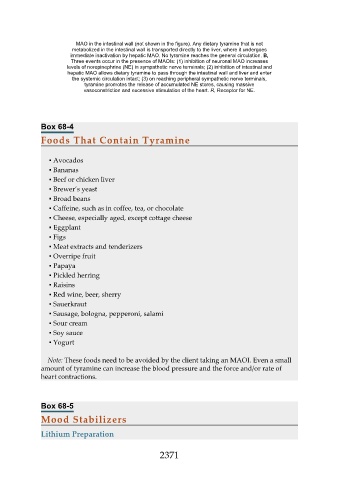Page 2371 - Saunders Comprehensive Review For NCLEX-RN
P. 2371
MAO in the intestinal wall (not shown in the figure). Any dietary tyramine that is not
metabolized in the intestinal wall is transported directly to the liver, where it undergoes
immediate inactivation by hepatic MAO. No tyramine reaches the general circulation. B,
Three events occur in the presence of MAOIs: (1) inhibition of neuronal MAO increases
levels of norepinephrine (NE) in sympathetic nerve terminals; (2) inhibition of intestinal and
hepatic MAO allows dietary tyramine to pass through the intestinal wall and liver and enter
the systemic circulation intact; (3) on reaching peripheral sympathetic nerve terminals,
tyramine promotes the release of accumulated NE stores, causing massive
vasoconstriction and excessive stimulation of the heart. R, Receptor for NE.
Box 68-4
Foods That Contain Tyramine
▪ Avocados
▪ Bananas
▪ Beef or chicken liver
▪ Brewer’s yeast
▪ Broad beans
▪ Caffeine, such as in coffee, tea, or chocolate
▪ Cheese, especially aged, except cottage cheese
▪ Eggplant
▪ Figs
▪ Meat extracts and tenderizers
▪ Overripe fruit
▪ Papaya
▪ Pickled herring
▪ Raisins
▪ Red wine, beer, sherry
▪ Sauerkraut
▪ Sausage, bologna, pepperoni, salami
▪ Sour cream
▪ Soy sauce
▪ Yogurt
Note: These foods need to be avoided by the client taking an MAOI. Even a small
amount of tyramine can increase the blood pressure and the force and/or rate of
heart contractions.
Box 68-5
Mood Stabilizers
Lithium Preparation
2371

